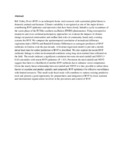Perspectives of predictive epidemiology and early warning systems for Rift Valley fever in Garissa, Kenya

View/
Date
2013Author
Nanyingi, M O
Muchemi, G M
Kiama, S G
Thumbi, S M
Bett, B
Language
enMetadata
Show full item recordAbstract
Rift Valley Fever (RVF) is an arthropod-borne viral zoonosis with a potential global threat to domestic animals and humans. Climate variability is recognized as one of the major drivers contributing RVF epidemics and epizootics that have been closely linked to cyclic occurrence of the warm phase of the El Niño southern oscillation (ENSO) phenomenon. Using retrospective reanalysis and cross sectional participatory approaches we evaluate the impacts of climate change on pastoral communities and outline their roles in community based early warning systems for RVF. We compare the spatiotemporal correlation of normalized difference vegetation index (NDVI) and Rainfall Estimate Differences as surrogate predictors of RVF outbreaks in Garissa over the past decade. A bivariate regression model to provide a month-ahead lead-time for earlier prediction of RVF is described. We also explore the recent RVF outbreaks linkage to other environmental conditions using long-term sentinel data collected on the field. The results indicate a significant correlation between elevated rainfall and NDVI (> 0.43) anomalies with recent RVF epidemics (P < 0.5). Persistent elevated rainfall and NDVI suggest that there is a likelihood of another RVF outbreak due to enhance vector competence. Given the nearly linear relationship between rainfall and NDVI it is thus possible to utilize these factors to examine and predict spatially and temporally RVF epidemics for effective surveillance with limited resources. This small-scale focal study will contribute to various existing predictive tools and present a good opportunity for preparedness and mitigation of RVF by local, national and international organizations involved in the prevention and control of RVF.
Citation
Nanyingi, M.O., Muchemi, G.M., Kiama, S.G., Thumbi, S.M. and Bett, B. 2013. Perspectives of predictive epidemiology and early warning systems for Rift Valley fever in Garissa, Kenya. Presented at the 47th annual scientific conference of the Kenya Veterinary Association, Mombasa, Kenya, 24-27 April 2013. Nairobi, Kenya: University of Nairobi.Publisher
University Of Nairobi
